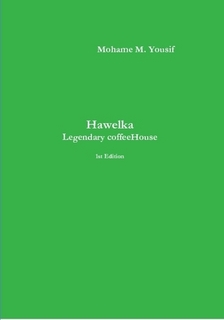Welcome Guest [Login]
Your last visit: 12-18-2025, 05:49 AM Home
|
|
 

  
|
Hawelka, Legendary coffeehouse
| 12-12-2014, 11:22 AM |
Mohamed Yousif
 Mohamed Yousif Mohamed Yousif
Registered: 10-24-2014
Total Posts: 295
|
|
 Hawelka, Legendary coffeehouse Hawelka, Legendary coffeehouse
|
Hawelka
Legendary coffeehouse
ISBN: 978-1-291-76641-7

Myself did I eagerly frequent!
Seeking peace of mind in Hawelka I settle.
Mingled with thoughts,
And blend in melted brilliance.
In Hawelka you inspire a song,
And Sail in the ocean of your dreams.
Surrounded by culture of all walks of life,
You enrich your endeavours for a better World.
Ah, Josefine, your smile and the plate of Buchteln,
We miss you so much!
Hawelka you left in good hands,
Your Son preserved your welcoming to the Guests.
M.Yousif
I was very much inspired by Hawelka Located in the center of Vienna; that I wrote a book about it, Reflecting the story behind it, and various Artists and prominent visitors since the end of the 2nd World war. Here are some extracts from the book:
After the end of the period of occupation after 1955, the cafГ© quickly became a meeting point for writers and critics like Heimito von Doderer, Albert Paris GГјtersloh, Hilde Spiel, Friedrich Torberg and Hans Weigel. After the closing of the CafГ© Herrenhof in 1961, even more artists gathered here and it became a central meeting place in the art scene of the time. Friedrich AchleitnerвҖҺ(53), H. C. ArtmannвҖҺ(40), Konrad BayerвҖҺ(34), Ernst FuchsвҖҺ(8), Friedensreich HundertwasserвҖҺ(41), Rudolf HausnerвҖҺ(10), Wolfgang HutterвҖҺ(11), Helmut QualtingerвҖҺ(27), Gerhard RГјhmand and Oskar WernerвҖҺ(38) were regular guests. In the sixties and seventies the cafГ© experienced its peak. Prominent and distinguished people from overseas like Arthur MillerвҖҺ(17), Andy WarholвҖҺ(29), the conductor Nikolaus HarnoncourtвҖҺ(18)and Omer AlshariefвҖҺ(19), came to swap ideas, drink Viennese coffee and indulge themselves with a plate of JosefineвҖҷs famous Buchteln, a type of Bohemian dumpling served with plum jam.
The artistic atmosphere of the cafГ© also inspired Georg Danzer's 1976 song Jö, schau (...was macht ein Nackerter im Hawelka). Josefine Hawelka passed away on March 22, 2005 after managing the cafГ© for sixty-six years with her husband.
Josefine Danz Berger, born 12, 1913 in Kirchdorf in Krems, the daughter of Fleischhauers in Upper Austria, went to Vienna at the age of 16. She worked as a waitress and met her future husband Leopold Hawelka. Josefine Hawelka passed away March 22, 2005 in Vienna and was buried in the Heiligenstadt cemetery. In 2012, in Vienna Donau City (22 district) der Josefine-Hawelka-Weg was named after her.
She had baked the place's specialty, Buchteln. GГјnther Hawelka, son of Josefine and Leopold continued baking Buchteln according to the old recipe). Until his death in 2011, Leopold Hawelka could still be found sitting at its entrance, greeting guests. In later years, inevitably, the cafГ© became something of a tourist destination.
In the immediate post-war period, when Vienna was split by the allied forces into Soviet, American, British and French zones, the CafГ© Hawelka was one of the few buildings in central Vienna that still had glass in its windows. Because of its proximity to the ChancellorвҖҷs palace in the Ballhaus-Platz, it also had electricity, so the Hawelkas were able to reopen in the winter of 1945.
(Edited by Mohamed Yousif on 12-18-2014, 10:45 AM)
|
|
     
|

|

|

|
|
|
|
| 12-12-2014, 11:33 AM |
Mohamed Yousif
 Mohamed Yousif Mohamed Yousif
Registered: 10-24-2014
Total Posts: 295
|
|
 Re: Hawelka, Legendary coffeehouse (Re: Mohamed Yousif) Re: Hawelka, Legendary coffeehouse (Re: Mohamed Yousif)
|
The earliest mention of coffee noted by the literary coffee merchant Philippe Sylvestre Dufour is a reference to bunchumвҖҺ(4)in the works of the 10th century CE Persian physician Muhammad ibn Zakariya al-RaziвҖҺ(5), known as Rhazes in the West, but more definite information on the preparation of a beverage from the roasted coffee berries dates from several centuries later.
The most important of the early writers on coffee was Abd al-Qadir al-Jaziri, who in 1587 compiled a work tracing the history and legal controversies of coffee entitled Umdat al safwa fi hill al-qahwa, in Arabic. He reported that one Sheikh, Jamal-al-Din al-Dhabhani (d. 1470), mufti of Aden, was the first to adopt the use of coffee (1454). He found that among its properties was that it drove away fatigue and lethargy, and brought to the body certain sprightliness and vigour. Sufis used it to keep themselves alert during their nighttime devotions. A translation traces the spread of coffee from Yemen) northward to Mecca and Medina, and then to the larger cities of Cairo, Damascus, Baghdad, and Constantinople.
Coffee beans were first exported from Ethiopia to Yemen. Yemeni traders brought coffee back to their homeland and began to cultivate the bean. The first coffeehouse opened in Constantinople in 1554. In 1511, it was forbidden for its stimulating effect by conservative, orthodox imams at a theological court in Mecca. However, these bans were to be overturned in 1524 by an order of the Ottoman Turkish Sultan Selim I, with Grand Mufti Mehmet Ebussuud el-İmadi issuing a fatwa allowing the consumption of coffee.
| |
     
|

|

|

|
|
|
|
Comments of SudaneseOnline.com readers on that topic:
Hawelka, Legendary coffeehouse
at FaceBook
Report any abusive and or inappropriate material
| |